Early ripening potato variety "Nandina" with good keeping quality
Ultra-early potato Nandina is a table variety of German selection, bred specifically to obtain 2-3 harvests per season. The crop does not require additional fertilizing with nitrogen during the formation of green mass and tubers, and does not require adherence to a watering regime, which greatly facilitates maintenance.
In the article we have collected detailed information about Nandina potatoes: description of the variety, nuances of agricultural technology, methods of combating late blight, Colorado potato beetle and wireworm.
Description of the variety
Nandina potato is an ultra-early variety bred by breeders of a German company Europlant Pflanzenzucht GmbH. Included in the State Register of Russia in 2015. The crop shows maximum productivity in the Volga-Vyatka, Central, and North Caucasus regions.
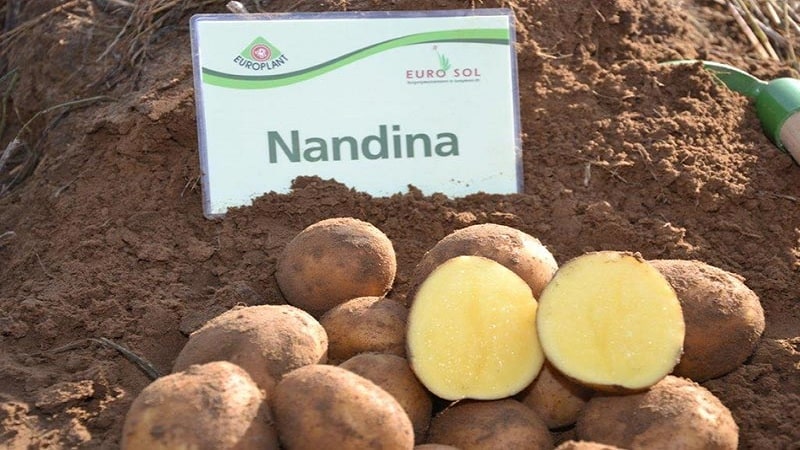
The photo shows Nandina potatoes.
The table contains main characteristics of the variety.
| Indicators | Characteristic |
| Ripening period | 40-45 days subject to prior germination |
| Bush | Medium height, leaf type, semi-erect |
| Number of tubers in a bush | 8-12 |
| Weight | 72-132 g |
| Form | Oval-round with small eyes |
| Coloring | Yellow peel and flesh |
| Leaves | Large, intermediate type, light green and green in color |
| Corolla color | Light purple with a red tint on the inside |
| Starch content | 12-15% |
| Taste | 4 on a five-point scale |
| Cooking class/group | B (medium crumbly) |
| Productivity | The first dig - 82-177 c/ha, the second - 115-238 c/ha, maximum yield - 329 c/ha |
| Marketability | 77-93% |
| Keeping quality | 93% |
| Purpose | Dining room |
| Sustainability | To wrinkle mosaic, leaf curl, crayfish, golden nematode |
| Transportability | High |
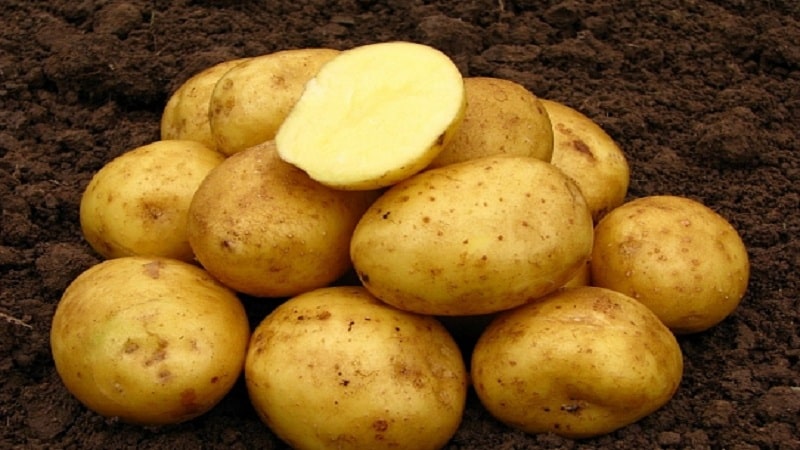
Chemical composition of potatoes
The table shows a complex of vitamins and minerals, contained in 100 g of raw tubers.
| Name | Content | Norm |
| Beta carotene | 0.001 mg | 5 mg |
| Vitamin B1 | 0.081 mg | 1.5 mg |
| Vitamin B2 | 0.032 mg | 1.8 mg |
| Vitamin B4 | 12.1 mg | 500 mg |
| Vitamin B5 | 0.295 mg | 5 mg |
| Vitamin B6 | 0.298 mg | 2 mg |
| Vitamin B9 | 15 mcg | 400 mcg |
| Vitamin C | 19.7 mg | 90 mg |
| Vitamin E | 0.01 mg | 15 mg |
| Vitamin K | 2 mcg | 120 mcg |
| Vitamin PP | 1.061 mg | 20 mg |
| Potassium | 425 mg | 2500 mg |
| Calcium | 12 mg | 1000 mg |
| Magnesium | 23 mg | 400 mg |
| Sodium | 6 mg | 1300 mg |
| Phosphorus | 57 mg | 800 mg |
| Iron | 0.81 mg | 18 mg |
| Manganese | 0.153 mg | 2 mg |
| Copper | 110 mcg | 1000 mcg |
| Selenium | 0.4 mcg | 55 mcg |
| Zinc | 0.3 mg | 12 mg |

Differences from other varieties
Table of differences from other early varieties potatoes.
| Name | Tuber weight, g | Starch content, % | Productivity, c/ha |
| Impala | 88–150 | 10,5–14,6 | 180–367 |
| Timo | 65–120 | 13,4–14,2 | 150–303 |
| Luck | 120–150 | 12–15 | 300–500 |
| Molly | 98–142 | 11,4–13,4 | 171–308 |
| Labella | 78–102 | 12–15 | 176–342 |
Advantages and disadvantages
Advantages of the Nadina variety:
- early ripening;
- the ability to collect 2-3 crops;
- resistance to most nightshade diseases;
- high productivity;
- ease of care;
- the flesh does not darken when cut and after cooking;
- keeping quality is 93%, allowing the harvest to be stored until spring.
Flaw - predisposition to late blight of tops and tubers.
Features of planting and growing
Variety Nandina is easy to care for. To grow the crop, standard agrotechnical techniques are used: watering as needed, hilling bushes, weeding, loosening the top layer of soil, fertilizing with minerals.
Preparing tubers for planting
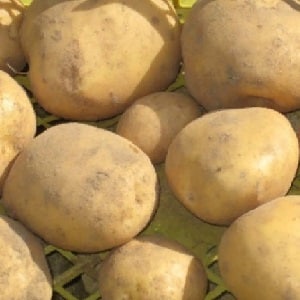 To get an early harvest and the opportunity to make three harvests, pre-selected tubers germinate. The seed material is taken out of the cellar into sunlight, re-sorted, rotten specimens are discarded, washed with running water, dried and soaked in a disinfecting solution. For this, copper sulfate, potassium permanganate, “Prestige”, “Fitosporin-M” are used. Then the tubers are placed in boxes with holes and wait for the seedlings to appear. The optimal room temperature is +14…+16°C.
To get an early harvest and the opportunity to make three harvests, pre-selected tubers germinate. The seed material is taken out of the cellar into sunlight, re-sorted, rotten specimens are discarded, washed with running water, dried and soaked in a disinfecting solution. For this, copper sulfate, potassium permanganate, “Prestige”, “Fitosporin-M” are used. Then the tubers are placed in boxes with holes and wait for the seedlings to appear. The optimal room temperature is +14…+16°C.
Before planting in the ground, seeds are treated with growth stimulants. “Epin-Extra”, “Zircon”, “Albit”, “Immunocytophyte” and re-sorted.
Soil preparation
Nandina grows best on gray light forest soils, peat bogs, sandy loams. Chernozem and heavy soil for this variety are not the best option.
In the fall, digging, harrowing and loosening of the soil are carried out. To increase fertility, the area is fertilized with manure at the rate of 5 kg per square meter. m, they sow flax, lupine, rye, oats, and wheat. After 30 days, the mowing of these green manures is buried in the soil to enrich the soil with nitrogen and prevent the development of pathogenic microflora.
Dates, scheme and rules of planting
Ideal ground temperature for planting potatoes +8…+10°С. The lunar calendar is used to calculate time:
- in the North Caucasus region, potatoes are planted in April;
- in Central - in early May;
- in Volgo-Vyatsky - from May 10 to May 15.
Planting scheme:
- depth - 8-12 cm;
- the gap between the holes is 30-35 cm;
- Row spacing is 70-90 cm.
200 g of wood ash and 25 g of nitrophoska are placed in each hole.
Care
Rules of care:
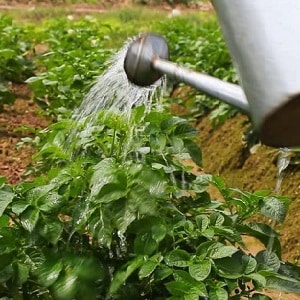 Watering. With normal rainfall, Nandina does not need regular watering. However, during drought, the bushes are watered once every 10 days.For hand irrigation, water after sunset to prevent sunburn on the leaves. When using a drip irrigation system, the soil is moistened at any time.
Watering. With normal rainfall, Nandina does not need regular watering. However, during drought, the bushes are watered once every 10 days.For hand irrigation, water after sunset to prevent sunburn on the leaves. When using a drip irrigation system, the soil is moistened at any time.- Loosening the soil. This procedure prevents the formation of a dense earthen crust and ensures free access of oxygen to the root system and tubers.
- Weeding. Weed removal is carried out as the plants grow, preventing rooting.
- Hilling is carried out twice: after the shoots reach 10-15 cm in height and during the flowering period. This helps strengthen the rhizome, protects against night frosts, and stimulates tuber formation.
- Top dressing. The variety does not require additional organic fertilizer during growth. Manure and ash introduced in the fall during planting are quite sufficient for the harmonious growth of tops and tubers. An excess of nitrogen provokes the growth of green mass and the shrinkage of tubers. If the tops turn yellow and dry, the bushes are additionally sprayed with a mineral solution a month before harvesting: 35 g of ammonium nitrate, 20 g of superphosphate per 10 liters of water.
- Mulching. This is a mandatory procedure, however, covering the beds with straw or hay will retain moisture in the soil and stop the growth of weeds.
Diseases and pests
According to the originator, the Nandina variety is susceptible to late blight of tops and tubers. The disease is caused by a fungus late blight - a mycelial lower organism that parasitizes plant tissues.
Signs of the disease:
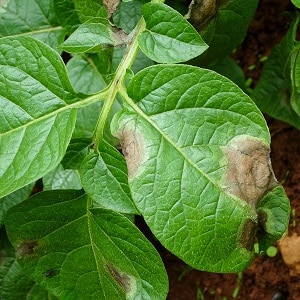 brown spots on the lower leaves;
brown spots on the lower leaves;- white coating on the back of the sheet;
- longitudinal brown stripes on stems;
- depressed brown spots with a gray tint on tubers;
- rusty necrotic lesions of the pulp;
- dry or wet rot on tubers.
Ways to fight:
- 200 g of dried tinder fungus per 2 liters of boiling water.Wrap the container in a warm cloth, leave until completely cool, then strain. Treat bushes once every 10 days.
- 500 g of wood ash, 100 g of tar soap shavings per 10 liters of water. Process plantings at any time.
- Systemic chemicals: Quadris, Ridomil Gold, Thanos, Infinito, Ordan, Acrobat MC. Treat plants every 10–12 days.
- Contact chemicals: “Antrakol”, “Azofos”, “Ditan”, “Zummer”. Treat bushes every 7–8 days.
- Copper-containing substances: “Oxychom”, “HOM”, “Polychom”, “Bordeaux mixture”. For 40 g of substance take 10 liters of water. Consumption per 100 sq. m - 6-8 l.
- Antimicrobial pharmaceutical drug "Trichopol". It is used when the first signs of the disease are detected. For 10 liters of water take 10 tablets and 40 drops of brilliant green. Treatment frequency: once every 14 days, every 10 days.
Prevention of late blight:
- planting healthy seeds;
- disinfection of tubers before germination;
- treatment with growth stimulants to increase plant immunity - “Epin”, “Zircon”;
- sorting tubers after germination;
- crop rotation;
- planting potatoes away from other nightshade crops;
- fertilizing with phosphorus and potassium.
To combat the Colorado potato beetle they use:
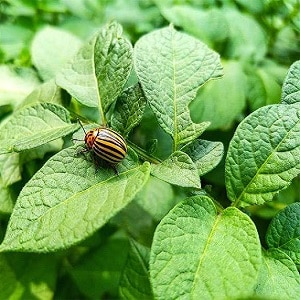 fungicides: "Prestige", “Aktara”, “Fury”, “Alatar”, “Cleanmix”, “Iskra Zolotaya”, “Commander”, “Aktelik”, “Korado”;
fungicides: "Prestige", “Aktara”, “Fury”, “Alatar”, “Cleanmix”, “Iskra Zolotaya”, “Commander”, “Aktelik”, “Korado”;- biological products: “Akarin”, “Fitoverm”, “Bitoxibacillin”, “Antonem-F”;
- solution of laundry soap (100 g of shavings, 1 liter of can of ash per 10 liters of water);
- birch tar solution (30 ml tar, 30 g soap shavings per 10 l);
- tobacco dust (500 g per 10 liters of water), leave for 2 days, dilute in a ratio of 1:2, add 40 g of laundry soap shavings;
- wormwood (300 g of fresh herbs, 200 g of wood ash per 10 liters of boiling water);
- celandine (1.5 kg per 10 liters of water, leave for 3 days);
- elecampane roots (100 g of dry raw materials per 5 liters of boiling water, leave for 2 hours).
Prevention of occurrence Colorado potato beetle:
- high hilling of beds;
- mulching the area with black agrofibre;
- treatment of plants with the preparation “Universal Humate”;
- planting plants with a strong aroma (marigolds, valerian, nasturtium), legumes, onions, garlic;
- regular weeding.
The appearance of wireworms on the site causes a lot of trouble gardeners. It is not very pleasant to see worms on potato tubers after harvesting.
Used for pest control:
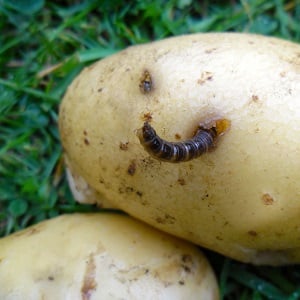 chemicals: “Zemlin”, “Barguzin”, “Aktara”, “Provotox”, “Pochin”, “Medvetox”, “Tabu”, “Prestige”, “Force”;
chemicals: “Zemlin”, “Barguzin”, “Aktara”, “Provotox”, “Pochin”, “Medvetox”, “Tabu”, “Prestige”, “Force”;- biological preparations “Metarizin”, “Entotsid”;
- nettle infusion (500 g of herb per 10 l);
- infusion of wormwood and celandine (150 g of herb per 5 l);
- infusion of coltsfoot (100 g per 5 l);
- walnut leaves and onion peels in the holes;
- mustard powder for deboning tubers before planting;
- bait made from pieces of carrots and potatoes soaked in any insecticide.
Prevention of occurrence wireworm:
- compliance with crop rotation rules;
- reducing soil acidity: adding chalk, dolomite flour, slaked lime;
- attracting starlings, crows, thrushes, doves, rooks, wagtails, tits, ladybirds, and ground beetles to the garden beds;
- planting potatoes after tomatoes, eggplants, peppers, beans, zucchini, cucumbers, flax, rye, alfalfa.
Collection, application and storage of crops
Rules for harvesting ultra-early potatoes:
- First they are digging 35–40 days after full germination, the last one at the end of August.
- A week before harvesting, the tops are cut and removed from the site.During this period, the peel becomes dense, which allows you to store the crop longer.
- After digging, the tubers are left to “rest” for 1–2 weeks in a dry, dark place, then sorted and stored in the cellar. The seed material is left in the sun for landscaping.
- The storage and containers are washed and dried. The tubers are placed in ventilated containers: plastic or wooden boxes, nets, burlap. The optimal storage temperature is +3...+4°C, humidity is 70-80%.
Reference. After harvesting, complex biochemical processes occur in the tubers, accompanied by the removal of excess moisture, compaction of the outer shell, and healing of damage.
The moderate starch content of Nandina potatoes allows them to be used for frying, boiling, baking, stewing. The pulp does not darken after cooking and cutting raw. The variety is grown primarily for young potatoes.
Features of cultivation and possible difficulties
Variety Nadina is highly sensitive to cold. Air temperatures below -4°C lead to the withering of the tops and the death of tubers. Ice crystals form in potatoes, destroying the cells. Frozen tubers begin to rot. For this reason, potatoes are planted after the threat of overnight frost has passed. To be on the safe side, in the first two weeks the beds are covered with black agrofibre.
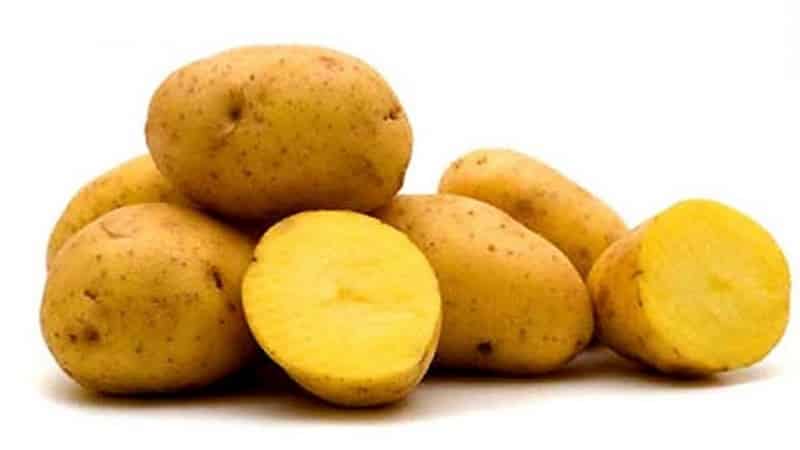
Tips and reviews
Reviews about the Nandina variety are mostly positive. The crop is valued for its early ripening, the ability to make 2-3 digs, and ease of care.
Vera, Zavolzhye: “When planting early potato varieties, I focus on the soil temperature. If the soil has warmed up to +10°C, you can safely plant tubers.Nandina is one of those varieties that is afraid of night frosts, so to be on the safe side, I cover the beds with film, and remove them after stable warm weather sets in. I like this potato for its low maintenance requirements. I fertilize the site in the fall with humus, and in the spring with wood ash. As my experience shows, this is enough to gain green mass and form tubers".
Dmitry, Pyatigorsk: “I grow the Nandina potato variety to get an early harvest. Its productivity is high and its taste is excellent. I noticed that potatoes become the most delicious closer to August. I use chicken manure as a fertilizer, fill it with water for a day, then add ash. I mix and dilute with water in a ratio of 1:10. I water the area with this mixture before planting. During the flowering period, I water it once and feed it with nitrophoska. Tubers are formed large, in large quantities".
Conclusion
The Nandina variety is able to quickly adapt to growing conditions, subject to the rules of planting and care. Planting is done in light, nutritious soil, with tubers previously sprouted and treated in a disinfecting solution.
The crop does not require strict adherence to watering and fertilizing regimes. The soil is moistened during the drought period once every 10 days, and fertilizers are applied before planting, taking into account the appearance of the tops. Withered bushes are fed with minerals, avoiding organic matter, the excess of which leads to a rapid gain of green mass and chopping of tubers.